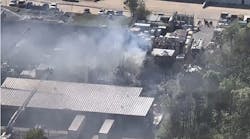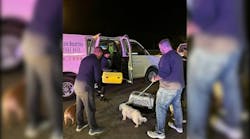At issue is California's Emergency Medical Service Act of 1980, which directed regional county EMS agencies to be established. A California Supreme Court ruling in May 1997 slammed the door to those cities and fire districts that wanted the decision-making power in their hands on whether a public or private agency would provide EMS transport. Cities or fire districts providing EMS transport prior to 1980 were exempted. Some cities have tried to solve the problem by creating their own EMS systems but the California Supreme Court's ruling said that unless the city had already been operating such a program before 1980, only the county had the authority to create and operate a new program.
It all started when the San Bernadino City Fire Department enacted regulations to govern ambulance transport that involved a private provider within its city. San Bernadino County then sued, claiming the county had sole jurisdiction for regulating EMS and ambulances within the city. Joining the City of San Bernadino were the Apple Valley Fire District, Barstow Fire District and Chino Valley Independent Fire District, as well as others. Later, in a strong show of support, the California Fire Chiefs Association, the Fire Districts Association of California, the California League of Cities and 121 other cities and fire districts filed amicus briefs to support the City of San Bernadino and its fire department. On the other side of the lawsuit were the County of San Bernadino, Courtesy Ambulance (which was eventually bought by AMR), the California EMS Authority and the California Ambulance Association.
In response to the lawsuit filed by the County of San Bernadino, in 1993, a California Superior Court ruling favored the fire service and the position of the cities. The case was then appealed to an appellate court, which also issued a ruling favorable to the fire service and cities in September 1995.
In response to this ruling, several fire departments started up their own EMS transport programs, contending that poor service was being provided in their communities. One such city was Ventura, which said it was dissatisfied with substandard service. In 1994, citizens of Ventura started a petition drive for the Ventura Fire Department to assume transport after long response times. The county had established a standard of 10 minutes for response 90 percent of the time to all emergencies - and permission to exceed 10-minute response times in 15 different circumstances.
At the time, Pruner Health Services, a Medtrans subsidiary, was supposed to commit three ambulances inside the City of Ventura at all times. However, it was not unusual to have two of the three doing routine transfer calls, leaving only one ambulance for a city of more than 100,000 people. Pruner would move other ambulances to cover the void but they often would only move to the fringes, not inside the city, still leaving only one ambulance.
In response to Ventura starting its own ambulance service on June 7, 1996, Pruner filed a lawsuit arguing against the city's decision to take over ambulance service. Pruner asked for a preliminary injunction to prevent the city from proceeding with the plans and asked the court to decide who has the ultimate authority to provide the service. At a June 24, 1996, hearing, a judge denied the injunction and the Ventura Fire Department entered the EMS transport business.
The appellate court decision in 1995 was appealed to the California Supreme Court by the counties and the private providers. In a setback to the fire service, on June 30, 1997, the California Supreme Court issued a ruling in the County of San Bernadino vs. the City of San Bernadino case. The ruling, which favored the counties and private providers, said, "We hold that the local EMS agency acted within its authority in subjecting the City to the medical protocols at issue in this case, that the City may not expand beyond the types of emergency medical services it provided as of June 1, 1980, and that the City may not exclude the County provider (Courtesy Ambulance) from furnishing such services."
In response to this ruling, cities which had begun their own EMS programs had to start dismantling them. The City of Ventura was one of those cities when three out of five Ventura County commissioners voted to take ambulance service away from the Ventura Fire Department and turn it over to AMR after being threatened with a lawsuit. Residents and city officials who testified at the public hearing before the Ventura County Commission said the Ventura Fire Department was providing faster and less-expensive emergency medical care. The proof was measurable. Response times had been cut by two minutes over AMR's and ambulance bills had been reduced by 40 percent. The City of Ventura's mayor even pleaded for a competitive bidding process for the transport contract but that fell on deaf ears.
The Ventura County commissioners also voted to include a provision for the City of Ventura to continue paying paramedics to staff its engines. Ventura city officials countered that removal of the ambulance service would leave a $750,000 hole in the budget and it was unlikely that the city could come up with the $350,000 to provide a free ALS service to AMR.
If the California fire service is successful with its legislation, provisions for determining EMS delivery will be made at the local and not the county level. Legislation supporters include the League of California Cities, California Professional Firefighters, California Fire Chiefs Association and the California State Firefighters Association. Written by Assemblywoman Deborah Oritz of Sacramento, Assembly Bill 2586 would let a city or fire district set up emergency medical service zones within city limits to reduce paramedic response times or increase the number of paramedics on an ambulance. In addition, the bill would require local EMS systems to be competitively bid beginning Jan. 1, 1999, effectively preventing counties from giving monopolistic control to private ambulance companies without the benefit of public input and a competitive bid process.
"We have more regulation and outcry over garbage service, for heaven's sake," said Oritz. "Cities must have the freedom to choose whether they want to provide emergency medical services and advanced life support and transport themselves."
To help promote Oritz's bill, the California Professional Firefighters (CPF) produced a TV commercial titled, "Protection Over Profits." CPF aired the commercial in the Sacramento market from March 25 through April 7, while the California legislature is in session.
At their March press conference, officials from Sacramento, Santa Clara and Ventura said their counties' control of contracts has often meant they were unable to do anything about slow responses to emergencies. Stewart Gary, a board member with the California League of Cities who is the chief of the Livermore-Pleasanton Fire Department, said, "Lives are at risk because the state law gives counties the ability to dictate what level of emergency medical service cities receive, without obtaining any input from those cities. If cities can provide this service better, faster and cheaper than the counties' private, for-profit operators, they should be allowed do so."
Gary added, "This is a situation that puts profits ahead of public safety. These for-profit private operators are trying to cut their costs at the expense of patients' welfare, and the counties are letting them get away with it."
Gary Ludwig will discuss "Don't Just Sit There - EMS During Fireground Operations" and "The State of Fire Service EMS" at Firehouse Emergency Services Expo '98 July 16-19 in Baltimore.
Gary Ludwig is the chief paramedic for the St. Louis Fire Department. He is serving his third term as an elected executive board member to the EMS Section for the International Association of Fire Chiefs and is a frequent lecturer at fire and EMS conferences. He has a master's degree in management and is a licensed paramedic. He can be reached at [email protected] or via fax at 314/645-9182.




